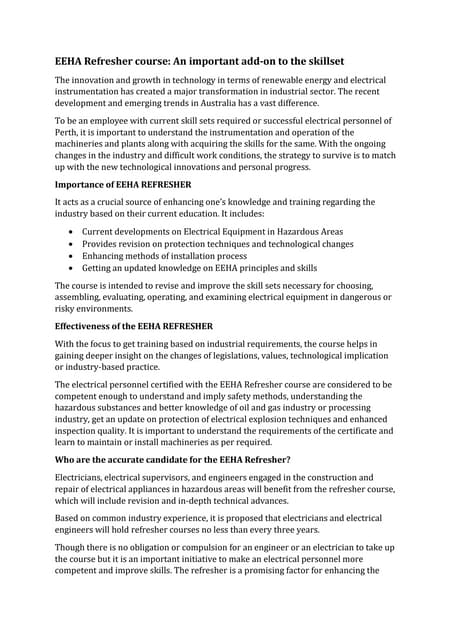Some Known Facts About Roar Solutions.
Some Known Facts About Roar Solutions.
Blog Article
The Definitive Guide to Roar Solutions
Table of ContentsFacts About Roar Solutions RevealedExcitement About Roar SolutionsThe Ultimate Guide To Roar Solutions
In order to shield installations from a prospective explosion an approach of evaluating and categorizing a possibly dangerous location is required. The function of this is to ensure the correct option and installation of tools to eventually protect against an explosion and to guarantee security of life.
(https://dzone.com/users/5292804/roarsolutions.html)
No devices ought to be mounted where the surface temperature level of the devices is above the ignition temperature of the provided danger. Below are some usual dust hazardous and their minimal ignition temperature. Coal Dirt 380C 225C Polythene 420C (thaws) Methyl Cellulose 420C 320C Starch 460C 435C Flour 490C 340C Sugar 490C 460C Grain Dirt 510C 300C Phenolic Resin 530C > 450C Aluminium 590C > 450C PVC 700C > 450C Residue 810C 570C The chance of the hazard being existing in a concentration high enough to cause an ignition will vary from area to area.
In order to classify this risk an installment is split into locations of risk depending upon the amount of time the dangerous exists. These areas are referred to as Zones. For gases and vapours and dirts and fibers there are 3 areas. Zone 0 Zone 20 A dangerous ambience is highly likely to be present and might be present for extended periods of time (> 1000 hours annually) and even constantly Zone 1 Zone 21 A hazardous environment is feasible however not likely to be existing for extended periods of time (> 10 450 C [842 F] A classification of T6 implies the minimum ignition temperature level is > 85 C [185 F] Hazardous location electric equipment possibly developed for use in higher ambient temperature levels. This would certainly showed on the ranking plate e.g. EExe II C T3 Ta + 60C( This means at 60C ambient T3 will certainly not be gone beyond) T1 T1, T2, T3, T4, T5, T6 T2 T2, T3, T4, T5, T6 T3 T3, T4, T5, T6 T4 T4, T5, T6 T5 T5, T6 T6 T6 A T Class ranking of T1 suggests the optimum surface temperature level created by the tool at 40 C is 450 C. Assuming the linked T Course and Temperature level ranking for the equipment are suitable for the area, you can always utilize a tool with a more rigid Division rating than needed for the location. There isn't a clear response to this question however. It actually does depend upon the sort of tools and what repair services need to be performed. Tools with details examination procedures that can not be carried out in the field in order to achieve/maintain 3rd party score. Must return to the manufacturing facility if it is prior to the equipment's solution. Field Repair Work By Authorised Personnel: Complicated testing might not be required nevertheless certain treatments may require to be complied with in order for the tools to keep its third event score. Authorised employees have to be used to execute the work correctly Fixing must be a like for like replacement. New component must be considered as a straight substitute requiring no unique testing of the tools after the repair is complete. Each tool with a hazardous ranking must be reviewed independently. These are laid out at a high level below, but for more comprehensive info, please refer straight to the standards.
Roar Solutions Fundamentals Explained
The equipment register is an extensive database of tools documents that consists of a minimum set of fields to determine each product's location, technological criteria, Ex-spouse classification, age, and ecological information. The proportion of Detailed to Close inspections will certainly be figured out by the Equipment Threat, which is evaluated based on ignition danger (the probability of a source of ignition versus the chance of a combustible environment )and the harmful area category
( Zone 0Area 1, or 2). Implementing a durable Risk-Based Evaluation( RBI )method is essential for making certain compliance and safety in taking care of Electric Tools in Full Report Hazardous Locations( EEHA).
Roar Solutions Can Be Fun For Anyone

In regards to eruptive threat, a dangerous location is a setting in which an eruptive environment exists (or may be anticipated to be existing) in quantities that require unique preventative measures for the building, installation and usage of devices. electrical refresher course. In this short article we check out the obstacles dealt with in the work environment, the danger control actions, and the needed expertises to function safely
It issues of modern life that we produce, keep or take care of a range of gases or liquids that are considered combustible, and a variety of dirts that are regarded combustible. These materials can, in specific conditions, create explosive environments and these can have major and terrible effects. Many of us know with the fire triangle eliminate any one of the 3 elements and the fire can not occur, however what does this mean in the context of harmful locations? When damaging this down right into its most basic terms it is essentially: a combination of a particular quantity of release or leak of a specific substance or material, combining with ambient oxygen, and the visibility of a resource of ignition.
In the majority of circumstances, we can do little regarding the levels of oxygen airborne, yet we can have significant influence on resources of ignition, as an example electric devices. Unsafe locations are recorded on the dangerous location classification drawing and are identified on-site by the triangular "EX" sign. Here, amongst other crucial information, zones are divided into 3 types depending upon the threat, the likelihood and period that an explosive ambience will exist; Area 0 or 20 is regarded one of the most unsafe and Zone 2 or 22 is deemed the least.
Report this page